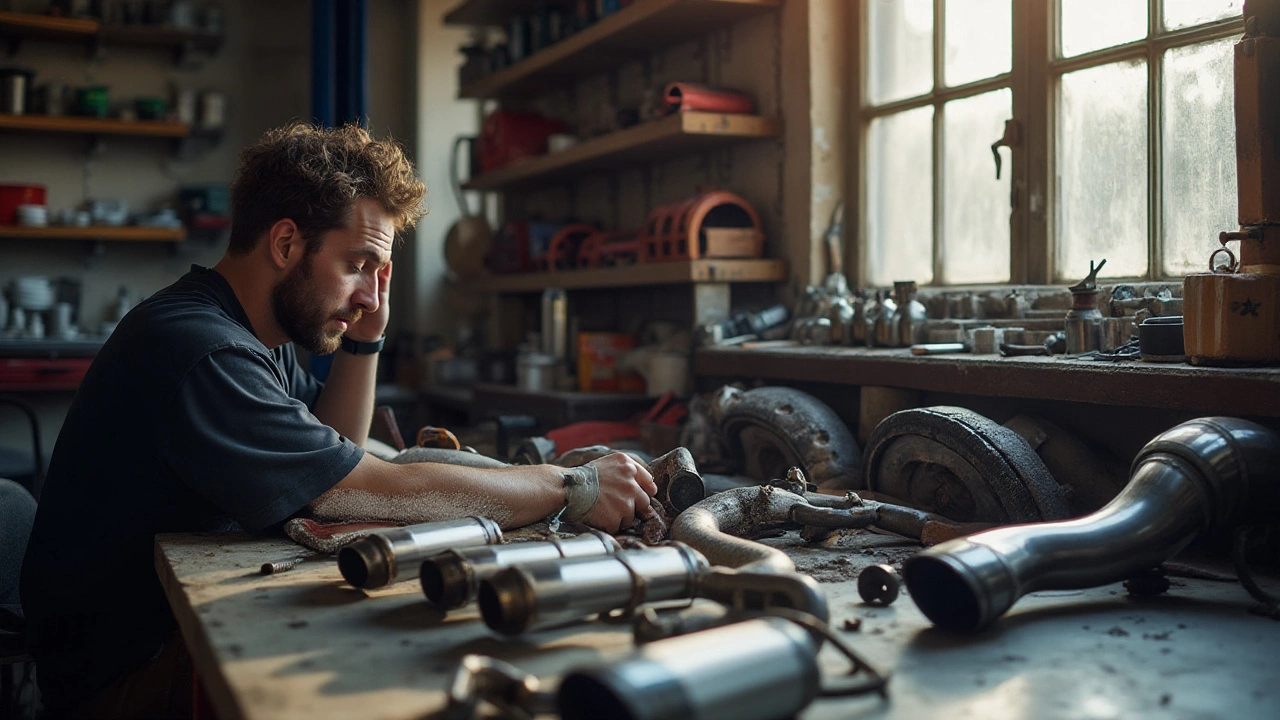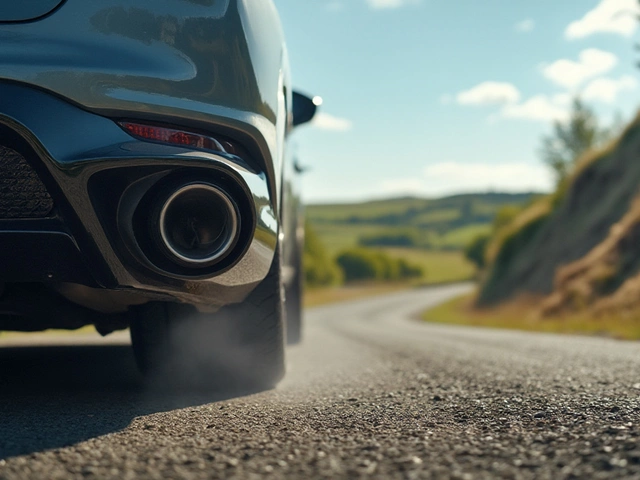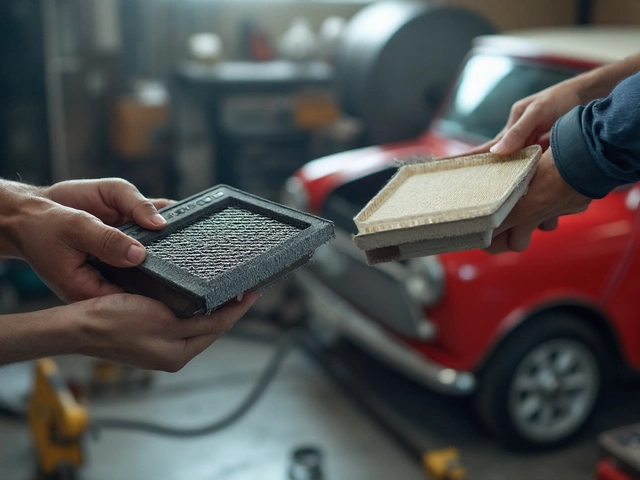When it comes to stepping up your vehicle's game, the exhaust system plays a starring role. Many car enthusiasts find themselves itching to swap out their factory setups to achieve better performance or just to add a bit of personal flair.
But with so many options on the market, choosing the right exhaust system can feel like navigating a maze. From understanding the types available to considering the benefits each brings, it’s about finding that sweet spot that combines sound, performance, and personality.
Whether you're new to the world of car modifications or a seasoned pro, there's always more to learn about pairing the right exhaust system with your on-road ambitions. Let's dive into what makes the heart of your car pump a little louder and stronger.
- Types of Exhaust Systems
- Benefits of Upgrading
- Choosing the Right System
- Expert Tips for Installation
Types of Exhaust Systems
Diving into the world of exhaust systems can be both fascinating and bewildering, especially with the range of options available. These systems are not just about making a car sound louder or more aggressive; they hold the potential to dramatically influence your car’s performance and fuel efficiency. At the very heart of this mechanical realm are several primary configurations. Each serves a unique purpose, tailored to fit different driver preferences and vehicular specifications.
The most universally recognized type is the cat-back exhaust system. This setup includes everything from the catalytic converter to the rear of the car, often incorporating a new mid-pipe, muffler, and tailpipe. The design is well-loved for being a straightforward modification that can enhance sound and potentially improve performance without major overhauls. It is favored among enthusiasts because it maintains emissions compliance while providing a moderate boost in horsepower. If you’re not looking to dive deep into your engine bay, this might be your golden ticket to a modest upgrade.
On a different plate, we find the axle-back exhaust system. It's somewhat like the cat-back’s younger sibling, covering only the area from the rear axles to the end of the vehicle. While it may not deliver as much performance enhancement as a cat-back might, it is a more budget-friendly option for those primarily seeking a change in sound or a slight gain in aesthetics. Many newcomers to car mods appreciate this option for the minimal effort involved and the ability to personalize the sound of their ride without committing to a full system swap.
For those seeking substantial performance gains, the header-back exhaust system is often the choice. Encompassing everything from the exhaust headers to the tailpipe, it provides a comprehensive upgrade that can significantly alter your car's performance metrics. This setup is perfect for performance-focused enthusiasts willing to invest the time and resources into an overhaul. Headers, being crucial in reducing back pressure and enhancing exhaust flow, play a pivotal role in maximizing engine output. Such systems are typically paired with other performance enhancements to unleash their full potential.
Carl Smith, a renowned automotive engineer, once noted, "Changing your exhaust system is like giving your car a new voice and a fresh pair of lungs at the same time."
Finally, worth mentioning is the turbo-back exhaust system, which is tailored specifically for turbocharged vehicles. This system includes components starting from the turbocharger outlet to the rear of the vehicle. The primary aim here is reducing back pressure, allowing the turbo to spool up faster and improve overall power delivery. Enthusiastic tuners often favour turbo-back systems due to their ability to maximize the turbo's efficiency while providing a robust sound profile.
Each type of exhaust system represents a unique approach for enhancing your vehicle’s capabilities, focusing either on performance, sound, or a perfect blend of the two. Understanding these differences helps drivers make informed decisions, allowing them to match their specific needs with the right system.

Benefits of Upgrading
For many, upgrading the exhaust system is akin to giving their vehicle a whole new personality. This isn’t merely about adding some chrome or a little bit of noise; it’s about waking the beast inside your ride. First and foremost, a major benefit that drives many to this change is the boost in performance. By replacing a factory exhaust with a more efficient system, you essentially open up your engine, allowing it to breathe more freely. The improved airflow reduces back pressure, a notorious culprit in hindering optimal engine efficiency. Enhanced airflow translates to better horsepower and torque, often resulting in the car reacting more briskly and with greater urgency to acceleration.
The improvement doesn't stop at performance. An upgraded exhaust system can drastically change the auditory experience of driving. Some drivers crave that throaty growl, a sound synonymous with power and precision, making them feel more connected with the vehicle’s capabilities. The sound isn't just about aesthetics; it communicates the engineering prowess beneath the hood. Adding to this, liberating your exhaust can lead to better fuel efficiency as the engine works less to push out the exhaust gases. This can be a surprising perk for those who assume that more power equals more fuel consumption.
We see aesthetics coming into play in a significant manner as well. Exhaust tips come in various designs and materials, from polished stainless steel to color-tinted titanium, allowing owners not only to improve performance but also to uplift the appearance of their vehicle's rear end. It's a visual statement of intent, showcasing that the vehicle's owner values detail and takes pride in their ride. Practical benefits are to be found in the weight reduction too. High-performance systems are often crafted from lightweight materials which shed those extra pounds that can make a considerable difference in how a vehicle handles and accelerates. This weight reduction is particularly favored in performance and racing circles where every kilogram counts.
"Changing your exhaust is one of the simplest ways to extract more power from your engine," says auto enthusiast and journalist Eric Adams. "It’s an upgrade you can feel in your seat and hear with your ears, making the driving experience more visceral."
Some may be surprised to know that certain upgraded exhaust systems are compliant with expanding emissions regulations, incorporating catalytic converters that offer superior gas filtration. This means you’re not just ramping up the fun factor but also maintaining or even exceeding environmental standards where required. Finally, the satisfaction of a custom exhaust note, personalized performance gains, and the bespoke aesthetic considerably enhances resale value. A record of tasteful, functional mods such as a quality exhaust upgrade may allure the right buyer willing to pay a premium when it’s time to part ways with your pride and joy. The car performance improvement paired with the sensory experience makes upgrading the exhaust system a highly rewarding endeavor for both the novice and seasoned car enthusiast.

Choosing the Right System
Deciding on the right exhaust system for your car is akin to crafting a symphony of performance and sound. Whether you're an adrenaline junkie yearning for that throaty growl on the racetrack or a purist hoping to increase efficiency, picking the right setup involves more than just price and brand. It begins with understanding how these systems work, their impact on the engine, and what precisely you’re aiming to achieve. There are single, dual, and even side-exit exhausts, each designed with specific performance outcomes in mind, offering varying degrees of noise reduction and power enhancement. The intricacies of these systems mean you have to dive into the knotty details - factors like pipe diameter, materials used (aluminum, steel, or even stainless steel), and catalytic converter compatibility. Consider the existing make and model of your vehicle, contemplate your driving habits, and research the environmental conditions you'll be subjecting your ride to. Remember, what might work for a weekend racer might not suit a daily commuter sedan.
In the realm of upgrades, considering your vehicle's make is crucial as well. A system that complements a Ford F-150 might not perform—or even fit—like you’d expect in a BMW M3, and vice versa. This is where tuning plays a crucial role. An exhaust system needs to be in harmony with the engine control unit (ECU) and overall build of the vehicle. An efficient exhaust system reduces back pressure and allows for a more free-flowing exhaust, which not only increases horsepower but can also improve fuel efficiency. The wrong choice can lead to poor performance levels or even engine check lights that will leave you perplexed on a Sunday drive.
For those new to the upgrade scene, consultation with industry experts and fellow enthusiasts can yield some golden advice. As one vehicular sage once put it,
"An exhaust system is like a tailor-made suit for your car; it needs to fit perfectly to bring out the best."Participating in forums, reading reviews, and testing demos can offer invaluable insights into what real-world outcomes you might expect. Walk into stores like a detective; ask your retailer direct, no-nonsense questions about installation, warranties, and what kind of support you can expect post-purchase.
If facts and figures pique your interest, here’s something to chew on. Loudness and output can increase dramatically with varying pipe diameters. For a point of reference, most stock systems possess a diameter in the realm of 1.75 to 2.25 inches, but performance systems often play in the 2.5 to 3-inch diameter field. Bigger isn't always better, though, as too much diameter can reduce backpressure needed, especially in naturally aspirated engines.
Costs will factor into your decision, for sure. While higher-end systems can run up quite a tab, requiring budgeting, there are cost-effective options that can provide excellent results, especially for those on a tight budget or those wanting to dip their toes into this whole 'upgrade' business. Luckily, today's market boasts an abundance of exhaustive resources (pun intended) to guide you in making the most fitting choice. A table summarizing potential gains you can achieve with each system type might look like this:
| System Type | Typical Horsepower Gain | Estimated Cost |
|---|---|---|
| Cat-Back | 5-10 HP | $300 - $1,500 |
| Axle-Back | 5-10 HP | $200 - $800 |
| Header-Back | 15-25 HP | $1,000 - $2,500 |
With this knowledge at hand, you’re not just swapping out car parts. You're crafting an identity for your ride. Armed with the right information, the path to that ideal exhaust system becomes less of a puzzle and more of a journey well-planned and executed. And trust me, when you hear that engine’s roar sync beautifully with your pulse, you'll know you made the right choice.

Expert Tips for Installation
Installing a new exhaust system can be incredibly rewarding, both for improving your car's performance and adding a custom touch to its style. But before you roll up your sleeves, it’s important to approach the task with a bit of planning and preparation. The first crucial step is to ensure that you have the right tools on hand. A comprehensive set of sockets and wrenches, as well as a jack and jack stands, are among the essentials. It’s not just about having them, but also knowing how to use each tool properly. When disconnecting the existing exhaust, pay attention to the gaskets and bolts, as these can tell tales about how the system was handling your car's stress. For vehicles that are older, expect to deal with rusted bolts, which may require a penetrating oil to ease.
The next phase involves a deep dive into the system and ensuring that all parts align exactly as they should. A common pitfall lies in underestimating the importance of the fittings and connections. These connections need to be just right to prevent any exhaust leaks, which can lead to performance issues or unwanted noise. Many seasoned mechanics recommend dry fitting the system before doing the full installation to identify potential trouble areas. It’s like a rehearsal run, but for your car parts! As you install the muffler or any custom exhaust tips, maintain a keen awareness of clearances and angles that may affect future maintenance or alterations.
Finishing Your Installation
After the main components are in place, don’t overlook the final touches. Tightening up doesn’t mean just going around and giving each bolt a little extra turn; it involves making sure each part is properly aligned and securely fastened without over-tightening, which can lead to cracks. Bolts should be torqued to your vehicle’s specifications, which you can usually find in the service manual. It's not just about finishing the job, but perfecting it to ensure the system lasts. An important tip comes from automotive expert John Rawlings, "A successful installation starts with patience and ends with a test drive to confirm everything is operating smoothly."
Once installation is complete, a test drive is crucial. Listen for any unusual sounds, and pay attention to performance changes. Any rattles or loss of power could indicate a misalignment or loose connection. Keep the manual handy and be ready to make slight adjustments if necessary. After a few drives, it’s advisable to re-check all fastenings, as vibrations can sometimes loosen up connections. It’s like a post-checkup to ensure every piece is doing its job right. In rare cases, enthusiasts find themselves swapping out sections due to mismatched components or personal sound preferences. Always have an evaluation period to ensure satisfaction with your newly fitted system.
| Installation Time | Difficulty Level | Cost Range |
|---|---|---|
| 2-4 hours | Moderate | $200-$600 |
Enthusiasts often find joy in the shared wisdom of community forums, where firsthand accounts can provide insights that manuals might overlook. Comparing notes about different experiences with exhaust upgrades is like having a road-map laid out by those who’ve traveled before you. Whether you’re onto your first install or a seasoned tinkerer, real-world experiences are an undervalued resource that can make all the difference. Armed with these expert tips and a bit of patience, you’re all set to enjoy the fruits of your labor—a smoother, louder, or even more efficient ride that turns heads and satisfies that craving for speed and power.






